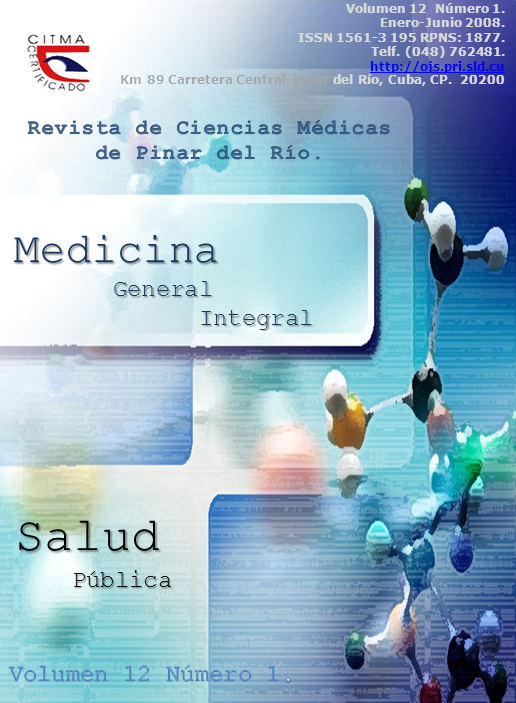Diagnóstico y prevención de enfermedades genéticas. Análisis de seis años del municipio Sandino / Diagnostic and prevention of the genetic diseases. Analysis of six years of the municipality Sandino
Abstract
Introducción: En los últimos años ha aumentado la importancia de las anomalías congénitas y enfermedades hereditarias como causa de muerte en el primer año de vida. El Programa de Diagnóstico y Prevención de Enfermedades Genéticas ha contribuido a la reducción de las tasas de mortalidad infantil, los indicadores de morbilidad mejorar la calidad de vida en la comunidad.
Objetivos: Realizar el análisis del comportamiento del Programa de genética médica en el municipio Sandino durante seis años de funcionamiento.
Método: Se realizó un estudio descriptivo, prospectivo, de corte longitudinal del total de gestantes desde el 1 de enero de 2000 hasta el 31 de diciembre de 2005, en las dos Áreas de Salud del municipio utilizando datos de la consulta municipal y provincial de Genética.
Resultados: 2388 gestantes asistieron a Consulta Genética Comunitaria. 725 de ellas (30.4%) se clasificaron con riesgo incrementado. Los principales fueron la edad materna avanzada, embarazo en la adolescencia y los antecedentes familiares. El 9.84% de las Alfafetoproteínas resultaron elevadas, 48.9 % sin causa explicable. 11 pacientes decidieron no realizarse el diagnóstico prenatal citogenético y de los realizados 1 fue positivo. Los 31 casos de malformaciones detectadas decidieron interrumpir el embarazo.
Conclusiones: El acercamiento de los Servicios de Genética Médica a la población y el desarrollo de la Genética Comunitaria facilitan la detección de riesgos si los casos son remitidos a tiempo al servicio de Genética. El embarazo en edades extremas conlleva los principales riesgos genéticos presentes en las gestantes estudiadas. Por cada fallecido se realizaron 6,2 interrupciones de embarazos por malformaciones.
Palabras clave: Mortalidad infantil. anomalía congénita, enfermedad hereditaria, diagnóstico prenatal.
ABSTRACT
Introduction: In the last years Congenital Anomalies and hereditary diseases have gained importance, as a cause of death during the first year of life. The program for the ¨Diagnosis and Prevention of Genetic Diseases¨ has contributed to the reduction of infant mortality rates, and the morbility indicators, and to improve the quality of life within the community.
Objective: To analyze how well the Genetic Program has been functioning in Sandino during the last six years.
Method: It was held to descriptive, prospective study of longitudinal out with 100% of all pregnant women from January 1st, 2000 up to December 31st, 2005, in two health areas of the municipality, using data found in both the municipal and the provincial community Genetics Medical Assistance.
Results: 2,388 pregnant women were attended in the community's Genetics Assistance, out of them just 725 (30, 4) were detected with increased risk. The main causes were advanced maternal age, teenage pregnancy and family records. Around 9.84% Alpha-fetoproteins reached high levels, 48.9% without a reasonable cause. Eleven patients decided not to go though the cytogenetic prenatal diagnosis and one resulted positive out of those carried out. The 31 cases of malformations detected decided to interrupt their pregnancy.
Conclusion: The approach of the Genetic Service in the population y the Community's Genetics assistance contribute to the detection of risks as long as they go to visit the Genetic Physician on time. Pregnancy in deadline age constitutes the main genetic risk present in the pregnant women studied. For each person deceased about 6.2 abortions of pregnancy were done because of malformations.
Key words: Infant mortality, genetic abnormalities, genetic diseases, prenatal diagnosis.
Downloads
How to Cite
Issue
Section
License
Authors who have publications with this journal agree to the following terms: Authors will retain their copyrights and grant the journal the right of first publication of their work, which will be publication of their work, which will be simultaneously subject to the Creative Commons Attribution License (CC-BY-NC 4.0) that allows third parties to share the work as long as its author and first publication in this journal are indicated.
Authors may adopt other non-exclusive license agreements for distribution of the published version of the work (e.g.: deposit it in an institutional telematic archive or publish it in a volume). Likewise, and according to the recommendations of the Medical Sciences Editorial (ECIMED), authors must declare in each article their contribution according to the CRediT taxonomy (contributor roles). This taxonomy includes 14 roles, which can be used to represent the tasks typically performed by contributors in scientific academic production. It should be consulted in monograph) whenever initial publication in this journal is indicated. Authors are allowed and encouraged to disseminate their work through the Internet (e.g., in institutional telematic archives or on their web page) before and during the submission process, which may produce interesting exchanges and increase citations of the published work. (See The effect of open access). https://casrai.org/credit/



